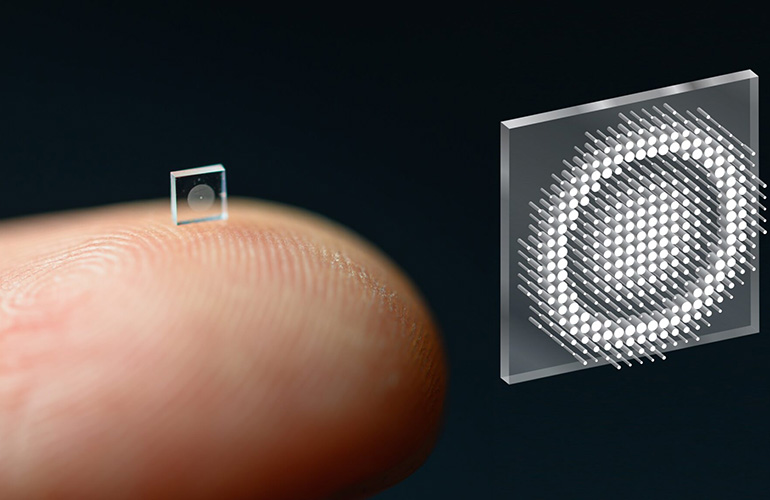|
Listen to this article  |

The ultra-compact camera uses over a million tiny posts to create a clear image.
Researchers at Princeton University and the University of Washington have created an ultra-compact camera the size of a coarse grain of salt. The researchers said it can take pictures as well as a camera 500,000 larger in volume. The tiny camera could someday be used in minimally-invasive endoscopies with medical robots to diagnose and treat diseases. The researchers also hope it could be used to turn surfaces into sensors.
Most cameras use a series of curved glasses or plastic lenses to capture images, but this camera uses metasurface technology. Instead of lenses, the tiny camera is studded with 1.6 million cylindrical posts. The posts all have unique sizes, and they function like optical antennas. The unique post shapes help to correctly shape the entire optical wavefront, to create a complete picture.
“It’s been a challenge to design and configure these little nano-structures to do what you want,” said Ethan Tseng, a computer science Ph.D. student at Princeton who co-led the study. “For this specific task of capturing large field of view RGB images, it was previously unclear how to co-design the millions of nano-structures together with post-processing algorithms.”
Shane Colburn, a co-lead author on the paper about the study, created a computational simulator that could test different post configurations. Each of the millions of posts interacts with light in different ways, so testing all of the different combinations is nearly impossible without the help of a computer.

Left, a picture taken by a typical ultra-compact camera. Right, a picture taken using the researchers’ new method.
While other metasurface cameras exist, the researchers said the pictures they take usually come out distorted, have a small field of view or have a limited ability to capture the full spectrum of light. This camera has unique integration of the design of the optical surface and signal processing algorithms that produce an image.
“Although the approach to optical design is not new, this is the first system that uses a surface optical technology in the front end and neural-based processing in the back,” said Joseph Mait, a consultant at Mait-Optik and a former senior researcher and chief scientist at the U.S. Army Research Laboratory.
This integration made it possible for the team’s camera to create full-color images in natural light, instead of with pure laser light in a lab or in other ideal conditions. Besides blurring at the edges of the frame, the images produced by the camera were comparable to a traditional lens.
Another coauthor on the paper, James Whitehead, fabricated the metasurfaces for the camera. The camera is made of silicon nitrade, a glass-like material, that is compatible with standard semiconductor manufacturing methods. This makes the camera similar to micro-chips in production, and means that they could be easily mass produced at a lower cost than the lenses in traditional cameras.
“We could turn individual surfaces into cameras that have ultra-high resolution, so you wouldn’t need three cameras on the back of your phone anymore, but the whole back of your phone would become one giant camera. We can think of completely different ways to build devices in the future,” said Felix Heide, the study’s senior author.
The research team hopes to optimize the image quality of the camera as well as add object detection and other sensing capabilities.
The entire paper written by the researchers can be found here.
Credit: Source link


Comments are closed.